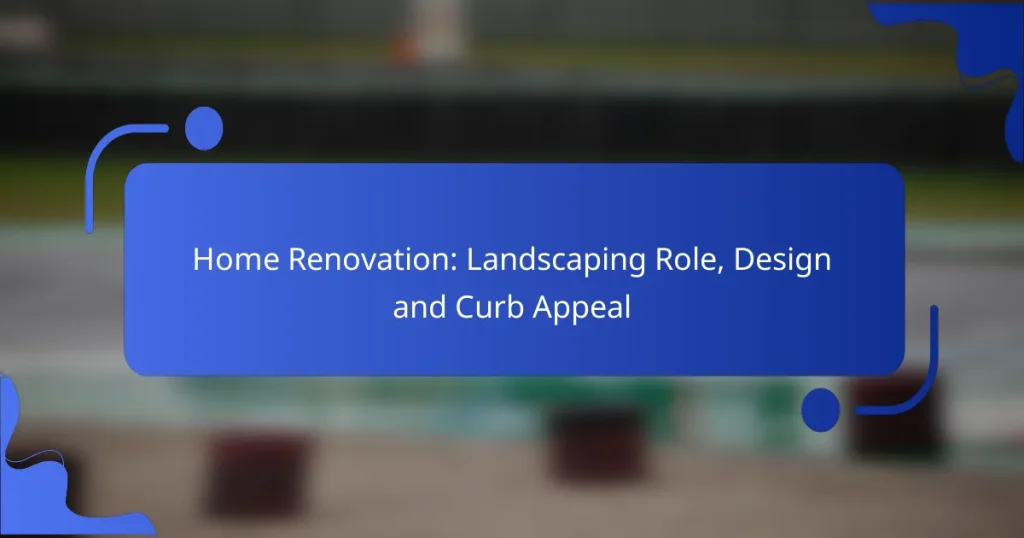Landscaping plays a crucial role in enhancing a home’s curb appeal, transforming outdoor spaces into inviting areas that attract potential buyers and visitors. By focusing on effective design elements such as plant selection, hardscaping, and lighting, homeowners can create visually appealing environments that improve both functionality and aesthetics. Choosing the right landscaping services is essential to ensure that the final result aligns with the homeowner’s vision and budget.

How does landscaping enhance curb appeal in home renovation?
Landscaping significantly enhances curb appeal by improving the overall visual attractiveness of a property. Well-designed outdoor spaces can create a welcoming first impression, making homes more appealing to potential buyers and visitors alike.
Improves visual aesthetics
Landscaping transforms a home’s exterior by adding color, texture, and structure. Features such as flower beds, shrubs, and trees can create a harmonious look that complements the architecture of the house. Incorporating elements like pathways, patios, and decorative stones can further enhance the visual appeal.
Consider using plants that bloom at different times of the year to ensure year-round interest. A well-maintained lawn and strategically placed lighting can also elevate the aesthetics, making the property stand out, especially during the evening hours.
Increases property value
Investing in landscaping can lead to a noticeable increase in property value, often yielding a return on investment of around 10-15%. Buyers are typically willing to pay more for homes with attractive outdoor spaces, as these features suggest a well-cared-for property.
To maximize value, focus on low-maintenance landscaping options that appeal to a broad audience. Native plants and drought-resistant designs can be particularly attractive in regions where water conservation is a priority.
Creates inviting outdoor spaces
Effective landscaping creates inviting outdoor areas that encourage relaxation and social interaction. Features like decks, patios, and outdoor kitchens can extend living spaces and make them more functional for gatherings and leisure activities.
Incorporating seating areas, fire pits, or water features can enhance the ambiance, making the outdoors a desirable place to spend time. When planning these spaces, consider the flow and accessibility, ensuring they connect seamlessly with the home’s interior.

What are effective landscaping design ideas for homes?
Effective landscaping design ideas for homes enhance both functionality and aesthetics, creating inviting outdoor spaces. Key considerations include plant selection, hardscape elements, and lighting, all of which contribute to the overall curb appeal.
Native plant gardens
Native plant gardens utilize flora that is indigenous to the local environment, promoting biodiversity and reducing maintenance. These plants are adapted to the local climate and soil conditions, making them more resilient and less reliant on water and fertilizers.
When designing a native garden, consider incorporating a variety of plants that bloom at different times to ensure year-round interest. For instance, in the U.S., combining wildflowers with shrubs can create a vibrant and sustainable landscape.
Hardscaping features
Hardscaping involves the use of non-plant elements like patios, walkways, and retaining walls to enhance outdoor spaces. These features provide structure and can define areas within the landscape, making them functional and visually appealing.
When planning hardscaping, choose materials that complement your home’s architecture. For example, natural stone or brick can add warmth, while concrete offers a modern look. Ensure that the layout facilitates easy movement and access throughout the yard.
Outdoor lighting solutions
Outdoor lighting solutions enhance safety and highlight landscaping features, creating an inviting atmosphere after dark. Options include pathway lights, spotlights for trees, and ambient lighting for patios.
When selecting outdoor lighting, consider energy-efficient LED fixtures that can withstand weather conditions. Aim for a mix of lighting types to create depth and interest; for instance, use soft lighting for seating areas and brighter lights for pathways to guide guests safely.

How can homeowners choose the right landscaping services?
Homeowners can choose the right landscaping services by evaluating local options, assessing their work quality, and obtaining clear pricing. This process ensures that the selected company aligns with the homeowner’s vision and budget.
Research local landscaping companies
Start by compiling a list of landscaping companies in your area. Use online directories, local business listings, and recommendations from friends or neighbors to identify potential candidates. Focus on companies that have experience with the specific type of landscaping you need, whether it’s garden design, hardscaping, or maintenance.
Check if the companies are licensed and insured, which protects you from liability in case of accidents. Local regulations may require specific permits for certain landscaping projects, so ensure the company is familiar with these requirements.
Check customer reviews and portfolios
Customer reviews are invaluable for assessing the reputation of landscaping companies. Look for feedback on platforms like Google, Yelp, or Facebook to gauge client satisfaction and service quality. Pay attention to recurring themes in the reviews, such as timeliness, communication, and overall results.
Additionally, request to see portfolios of previous work. A good landscaping company should have a collection of photos showcasing their projects. This will help you determine if their style aligns with your vision and if they have experience with similar projects.
Request detailed quotes
Once you have narrowed down your options, request detailed quotes from the top candidates. A comprehensive quote should outline the scope of work, materials needed, labor costs, and any additional fees. This transparency helps you compare services effectively.
Be cautious of quotes that seem significantly lower than others, as they may indicate subpar materials or rushed work. Ensure that all aspects of the project are covered in the quote to avoid unexpected costs later on.

What are the costs associated with landscaping renovations?
Landscaping renovations can vary significantly in cost, typically ranging from a few hundred to several thousand dollars depending on the scope of the project. Factors such as design complexity, materials used, and labor costs all influence the overall expense.
Average landscaping project costs
The average cost for landscaping projects can range from about $1,500 to $5,000 for basic improvements like planting trees or shrubs. More extensive renovations, such as installing patios or retaining walls, can push costs to between $5,000 and $15,000 or more. High-end designs with intricate features may exceed $20,000.
Factors affecting pricing
For example, hiring a landscape architect may increase initial costs but can lead to better long-term value through optimized design. Always consider obtaining multiple quotes to ensure competitive pricing.
Budgeting for maintenance

What landscaping trends are popular in urban areas?
In urban areas, popular landscaping trends focus on maximizing limited space while enhancing aesthetics and sustainability. Key trends include vertical gardens, eco-friendly landscaping, and smart irrigation systems, each contributing to improved curb appeal and environmental benefits.
Vertical gardens
Vertical gardens, or green walls, utilize vertical space to grow plants, making them ideal for urban settings with limited ground area. These installations can be made from modular systems or custom-built frames, allowing for a variety of plant choices, including herbs, flowers, and succulents.
When considering a vertical garden, assess sunlight exposure and plant compatibility. Regular maintenance, such as watering and pruning, is essential to keep the garden thriving. Local regulations may also dictate specific plant types to avoid invasive species.
Eco-friendly landscaping
Eco-friendly landscaping emphasizes sustainability by using native plants, reducing water usage, and minimizing chemical fertilizers. This approach not only conserves resources but also supports local wildlife and promotes biodiversity.
To implement eco-friendly landscaping, choose drought-resistant plants and incorporate mulch to retain moisture. Rain gardens can also be effective in managing stormwater runoff. Be mindful of local guidelines regarding plant selections and landscaping practices to ensure compliance and environmental harmony.
Smart irrigation systems
Smart irrigation systems optimize water usage by using technology to monitor weather conditions and soil moisture levels. These systems can significantly reduce water waste, making them a practical choice for urban landscapes where water conservation is crucial.
When selecting a smart irrigation system, consider features like weather sensors, programmable timers, and mobile app integration for remote management. Regularly check for leaks and system efficiency to ensure optimal performance and compliance with local water usage regulations.

How does landscaping impact home energy efficiency?
Landscaping can significantly enhance home energy efficiency by providing natural insulation and reducing heating and cooling costs. Strategic placement of trees, shrubs, and other plants can create shade in the summer and windbreaks in the winter, leading to lower energy consumption.
Benefits of Strategic Planting
Planting trees and shrubs in the right locations can effectively lower energy bills. For instance, deciduous trees planted on the south and west sides of a home can provide shade during hot months, reducing air conditioning needs by up to 30%. In winter, these trees lose their leaves, allowing sunlight to warm the home.
Additionally, evergreen trees can serve as windbreaks, reducing heating costs by blocking cold winds. This combination of shade in summer and protection in winter creates a more stable indoor climate.
Choosing the Right Plants
Selecting appropriate plants is crucial for maximizing energy efficiency. Native species are often more resilient and require less water, making them a sustainable choice. Consider the mature height and spread of trees to ensure they do not obstruct sunlight or airflow to your home.
For optimal results, consult local landscaping guidelines or a horticulturist to choose plants that thrive in your climate and soil conditions. This ensures that your landscaping efforts contribute positively to energy efficiency.
Maintenance Considerations
Regular maintenance of your landscaping is essential for sustaining its energy efficiency benefits. Pruning trees and shrubs helps maintain their shape and ensures they do not block windows or vents. Mulching around plants can retain moisture and reduce the need for irrigation.
Be mindful of the growth patterns of your plants and adjust their placement as needed. A well-maintained landscape not only enhances energy efficiency but also boosts curb appeal and property value.

